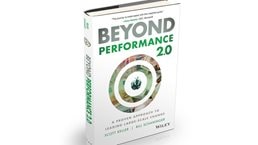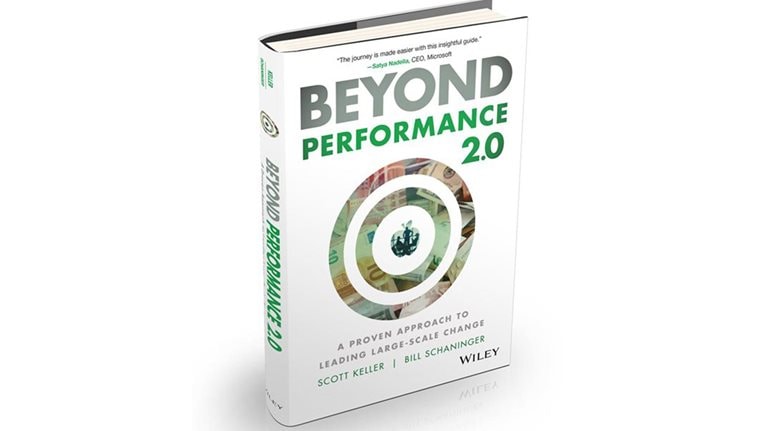A surefire way to shoot yourself in the foot when you’re leading a large-scale change effort is to ignore what’s on the minds of your employees. In research we conducted for our recently published book, Beyond Performance 2.0 (John Wiley & Sons, July 2019), we found that executives at exactly zero companies that disregarded an analysis of employee mind-sets during a change program rated the transformation as “extremely successful.” Conversely, executives at companies that took the time and trouble to address mind-sets were four times more likely than those that didn’t to rate their change programs as at least “successful.”
Those numbers reflect the power of mind-set shifts. In human systems, they help to achieve the same effect as the transformation of a caterpillar into a butterfly or a tadpole into a frog: when employees become open to new ways of looking at what’s possible for them and their organization, they can never return to a state of not having that broader perspective, just as butterflies and frogs can’t revert to their previous physical forms. To achieve such a metamorphosis, leaders must first identify the limiting mind-sets, then reframe them appropriately, and finally make sure that employees don’t revert to earlier forms of behavior. In this article, we take readers through the process to shift mind-sets, with a particular emphasis on why the final stage is so important and so difficult.
Identify the root causes of behavior that helps or hinders
The story of the Manchester Shoe Company, told by Benjamin Zander in his book The Art of Possibility, neatly encapsulates the significance of a positive mind-set. In the early 1900s, inspired by a desire to enter a faraway market, two traveling salesmen were sent as a beachhead into the region. A few days later, two telegraphs came back independently. One said, “Situation horrible. They don’t wear shoes!” The other said, “Glorious opportunity; they don’t have any shoes yet!” Imagine what would have happened if the company had acted only on the first message.
Now consider Gary Hamel and C. K. Prahalad’s management fable of four monkeys sitting in a cage staring at a bunch of bananas accessible only by steps hanging from the roof. Whenever the monkeys try to climb the steps to reach the bananas, a blast of cold water blocks them. After a few days, realizing there’s no point in trying to get the “forbidden fruit,” they naturally give up. Some humans in the room then remove the water hose and, at the same time, replace one of the original monkeys with a new one. On seeing the bananas, it starts up the steps, but the other simians, being social creatures, pull it down before it gets blasted by water. The new monkey is startled, looks around, and tries repeatedly to scale the ladder, only to be repeatedly pulled back. Finally, the new monkey accepts the group code of conduct and doesn’t bother to go for the bananas.
Over the next few weeks, the onlookers remove the rest of the original monkeys, one at a time, and replace them with new monkeys that have never seen the water. By the end of the experiment, with perfectly ripe bananas sitting on the platform above, and monkeys that have never seen a jet of water, none of the animals tries to climb the steps. They’ve all learned the unwritten rule: “you don’t grab the bananas around here.”
Hamel and Prahalad created this story not to represent any actual findings from the field of primatology but instead as a potent and memorable way to demonstrate a wider truth about organizational life—namely, that mind-sets ingrained by past management practices remain ingrained far beyond the existence of the practices that formed them, even when new management practices have been put in place.
Here are three business examples that underscore the perils of ignoring this lesson. Example one: a bank that identified how its high performers succeeded in cross-selling decided to roll out a change program with support scripts and good profiling questions for the other bankers to use—and was dismayed to find that these moves had a negligible impact on sales. A second example: a telco introduced a dramatically simplified process and rating system for performance reviews only to find that its leaders still avoided delivering tough messages. Finally: a manufacturer invested hundreds of millions in a knowledge-management technology platform meant to discourage hoarding and encourage collaboration—only to declare, several months later, that the system had been a complete failure.
In all these examples, the companies did a good job of recognizing the behavioral change needed to achieve the desired goals. Yet they didn’t take the time, or use the tools available, to understand why smart, hard-working, and well-intentioned employees continued to behave as before (see sidebar, “Uncovering unconscious mind-sets”).
At the bank, for instance, two seemingly good but ultimately performance-limiting mind-sets accounted for the failure of the new sales-stimulation tools and training. The first was “my job is to give the customers what they want”; the second, “I should follow the Golden Rule and treat my customers as I would like to be treated.” At the telco, employees had a deep-seated, reasonable-sounding belief that “criticism damages relationships.” At the manufacturing company, people had an underlying conviction that “around here, information is power, and good leaders are powerful leaders.”
The upshot? By looking at—and acting on—only observable behavior, company leaders overlooked its underlying root causes. Consequently, the change efforts of all three organizations led to disappointment.
Reframe the root causes
Once the root-cause mind-sets are identified, the next step is to reframe those beliefs and thereby expand the range of reasonable behavioral choices employees make, day in and day out. That creates the caterpillar-to-butterfly effect described earlier. Would different beliefs, for example, have inspired expanded and better-informed behavioral choices for average-performing bankers? If so, which beliefs? Suppose they believed that their job—indeed, the way they add value for others—was to “help customers fully understand their needs” rather than “giving customers what they want.” Also, what if instead of applying the “Golden Rule,” bankers applied the “Platinum Rule”: treating others as they (rather than bankers) want to be treated.
And what if the telco executives, in their performance-management discussions, had believed that “honesty—combined with respect—doesn’t damage relationships; in fact, it is essential to building strong ones”? And what if the manufacturing managers had thought that “sharing information rather than hoarding is the best way to magnify power”? Had they believed that, the company very likely wouldn’t have needed an expensive (and ultimately futile) knowledge-management system to help employees reach out to one another and share best practices.
Beneath each of the reframes described above, it’s important to note, lies a deeper shift in worldview. For example, moving from the giving-customers-what-they-want mind-set to helping them fully understand what they really need reflects a move from subordinate to peer. Recognizing that honesty builds rather than destroys relationships reflects a shift from victimhood to mastery. And choosing to believe that power is expanded by sharing information, not that hoarding information is power, focuses on abundance, not scarcity.
The best examples of naming and reframing are not only profound (using practical, relatable terms that reflect these deeper changes in worldview) but also insightful (raising the subconscious to consciousness in ways that expand possibility), memorable (so issues can easily be raised and discussed in day-to-day work), and meaningful (specific to the organization and evoking a “that’s so us!” response).
In this way, a retailer found it vital to shift from “listening and responding” (a reactive mind-set) to “anticipating and shaping” (a proactive one), and an engineering company that wanted to improve the way it captured external ideas found that it was consistently overoptimistic about results and underestimated its competitors. This company came to realize that these shortcomings were driven by a “winning means being peerless” (expert) mind-set, which led to increasingly insular behavior. Changing to the learner mind-set—“winning means learning more and faster than others”—prompted employees to look for best practices in competitors and beyond.
Human-health analogies reinforce the message of business examples. Consider the predicament of people with heart disease. Years of research have shown that most cardiac patients live considerably longer if they cut out smoking and drinking, eat less fat, reduce their stress levels, and exercise regularly. Indeed, many patients make a real effort to do so. Yet study after study has shown that 90 percent of people who have undergone surgery for heart disease revert to unhealthy behavior within two years.
Dean Ornish, a professor of medicine at the University of California at San Francisco and founder of the Preventive Medicine Research Institute, decided to reframe the underlying mind-set beneath the patients’ narratives. He wanted to change it from “If I behave this way, I won’t die” (fear driven) to “If I behave this way, my life will be filled with joy” (hope driven). In his words, “Telling people who are lonely and depressed that they’re going to live longer if they quit smoking or change their diet and lifestyle is not that motivating. Who wants to live longer when you’re in chronic emotional pain?” How much better would they feel, he thought, if they could enjoy the pleasures of daily life without suffering any pain or discomfort? In his experiment, 77 percent of his patients managed to make permanent changes in their lifestyles, compared with a normal success rate of 10 percent.
Make the change personal
Reframing the root causes of mind-sets that block change is a critical step in the right direction and can sometimes create the desired shift in behavior on its own. At the aforementioned bank, for example, once employees were exposed to the Platinum Rule, they could immediately see how much more productive following it would be. They simply had never previously thought about the impact on customers of the way bankers had been relating to them.
More often than not, however, employees struggle to change their behavior for reasons that are more emotional than intellectual. The single biggest barrier to rapid personal change, after all, is our propensity as leaders to say, “Yes, that’s the problem and the shift we need. If only others would change how they think and behave, we would make more progress.”
At one company we know, for example, leaders were asked to estimate how much time they spent tiptoeing around other people’s egos: making others feel that “my idea is yours,” for instance, or taking care not to tread on someone else’s turf. Most said 20 to 30 percent. Then they were asked how much time they spent tiptoeing around their own egos. Most were silent. Psychology explains this dynamic as a very predictable, and very human, “self-serving bias.” It involves viewing our own actions favorably and interpreting events in a way beneficial to ourselves. This explains why 25 percent of students rate themselves in the top 1 percent in their ability to get along with others. It’s why, when couples are asked to estimate their contribution to household work, the combined total routinely exceeds 100 percent.
In many behavior-related areas, we human beings consistently overestimate how much we are part of the solution, not the problem, and role modeling change is one of these areas. On average, when leaders are asked if they “role model desired behavior changes,” a full 86 percent report that they do. When the same question is put to people who report to these leaders, it receives only a 53 percent average positive response.
How best, then, to overcome this bias and help leaders and employees commit to changing themselves? Our own journey has led us to the deep conviction that offsite, workshop-based learning journeys of small groups of 20 to 30 employees are the most powerful intervention. These are typically centered on in-person working sessions, over two days, led by facilitators experienced in the principles of adult learning and knowledgeable in techniques developed in the field of human potential. The workshop methodology is grounded in the “U-process”—a social technology developed during a ten-year partnership between Generon International, Otto Scharmer and Peter Senge from the Massachusetts Institute of Technology, and the Society for Organizational Learning. The U-process has three phases:
- Sensing. This typically involves a senior leader who has already been through the workshop and shares the company’s change story, describes her or his own personal change journey, and answers questions from participants.
- Presencing. This involves participants exploring their personal “iceberg” of behavior. It includes working through modular, discussion-based content and questions that equip leaders to achieve new levels of self-awareness and self-control. “Where and why do I act out of fear rather than hope? Scarcity rather than abundance? Victimhood rather than mastery? And what would be the result if I made different choices?”
- Realizing. In this phase, participants make explicit, public choices about personal mind-sets and behavioral shifts; identify “sustaining practices” that will help them act on their insights; and reflect on how they will engage their personal networks for the challenges and support they will need during the rest of their personal change journey.
Following these workshops, small groups typically convene to offer peer accountability and advice. After a number of weeks, there is a further facilitated session to take stock of changes in behavior.
We acknowledge that this approach will sound unduly “soft” to some. But we’ve seen it have a transformational impact on everyone from Dutch engineers to American investment bankers to Middle Eastern government officials to employees of South Korean conglomerates. While some organizations put all their employees through such a workshop, they can achieve most of the impact through a critical mass of people leaders, which the field of epidemiology has shown to be, typically, 25 to 30 percent of the total. In these cases, all leaders eventually shed the “if only they would change” mentality and replace it with a profound sense of “if it’s to be, it’s up to me.”
Not every successful change program we have seen uses these techniques, but in our experience every change program that used them (in the context of other recommended interventions) has been successful, and in time frames far faster than most leaders had expected. The effect can be particularly positive when organizations grapple with how to thaw what’s often referred to as “the frozen middle”—a change-resistant layer of middle managers.
Reshape the work environment
Victor Frankl was an Auschwitz survivor whose seminal book, Man’s Search for Meaning, has long challenged and inspired readers across academic and professional disciplines. He summed up, in a compelling way, the full picture of what it takes to achieve caterpillar-to-butterfly-like personal change when he wrote: “Between stimulus and response there is a space. In that space is our power to choose our response.” We find it helpful to use a shorthand version of Frankl’s idea: S (stimulus) + T (how you choose to think about the stimulus) = R (response).
The S in this equation is vital for the aforementioned work on the T to fully take hold: after all, as the story of the monkeys illustrates, the work environment is a particularly powerful shaper of employee mind-sets and behavior, albeit a relatively slow-acting one. Nonetheless, if employees come out of workshops committed to change but find themselves back in the very same work environment that had ingrained their original mind-sets, it’s far less likely that the new mind-sets will become truly personal—or permanent.

Beyond Performance 2.0: A Proven Approach to Leading Large-Scale Change
By way of analogy, imagine that you go to the opera on Saturday and to a sporting event on Sunday. At the climax of the opera, the very best part, you sit silent and rapt in concentration. You and the rest of the audience then offer a genteel clap. At the climax of the sporting event, also the very best part, you leap to your feet, yelling and waving and jumping up and down. You haven’t changed; you are the same person with the same feelings, values, and needs. But your context has changed, and so has your mind-set about the behavior that is appropriate for expressing appreciation and enjoyment—and therefore the behavior you choose to exhibit and the practices you choose to participate in.
When it comes to changing the stimulus (the S)—the work environment—employees are exposed to, we find that the four levers in McKinsey’s “influence model” offer the most practical and proven guide (exhibit).1 Our research and experience demonstrate that changes in thinking and behaving will be significant and sustained if leaders and employees see clear communications and rituals (the understanding and conviction lever); if supporting incentives, structures, processes, and systems are in place (the formal-mechanisms lever); if training and development opportunities are combined with sound talent decisions (the confidence and skills lever); and if senior leaders and influence leaders2 allow others to take their cues from the leaders’ own behavior (the role-modeling lever).

Many leaders wonder which of the four levers is the most important. Evidence shows that they all matter, with minor statistical variations in degree, and that people do not have to experience them in any particular order—the key is to ensure that all of them are experienced consistently. Communicating to employees that you want them to adopt sports-stadium mind-sets, practices, and behavior is no use if your evaluation systems, and the leadership moves that employees see, are those of the opera house. If you want people to think like sports fans, you must create a stadium environment that encourages and enables them to think and act differently.
We’ve discussed the importance and value of both the stimulus (the S) and the thinking (the T) separately, but in reality they are profoundly linked. One person’s mind-sets (the T) drive that person’s behavior (the R), which becomes the role-modeling part of the S for those who interact with this person—a testament to the importance of starting changes in the T at the top.
It’s no accident that we’ve used a lot of stories in this article. Storytelling is powerful: it goes beyond facts and figures to stimulate and shape mind-sets. Thinking in terms of stories is also a helpful reminder that change is ultimately personal, as every story is open to individual interpretation and individual meaning. Along the same lines, if you want to lead change, you must take on both the contextual and personal dimensions. Mastering them is a challenge but also can be incredibly rewarding—not just for the organizations and people you’re trying to lead but also for you as a leader and, ultimately, as a person.
This article is adapted from the authors’ new book, Beyond Performance 2.0: A Proven Approach to Leading Large-Scale Change (John Wiley & Sons, July 2019).


